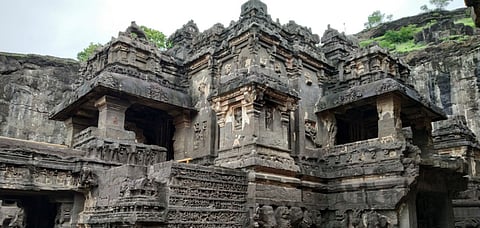
- Destinations
- Experiences
- Stay
- What's new
- Celebrating People
- Responsible Tourism
- CampaignsCampaigns
- SubscribeSubscribe
- Buy Now

India's temples have always fascinated travellers with their rich history and stunning architecture. Among them, the Kailasa Temple&ndashthe largest of the 34 carved temples constituting the Ellora Caves in Maharashtra&ndashis one. The Kailasa Temple holds the distinction of being the world's largest monolithic rock structure. Carved into the vertical basalt cliffs of the Sahyadri Hills, this temple complex showcases the brilliance of Indian architecture. Its dimensions span around 300 feet in length and 175 feet in width while emerging from a scarp towering over 100 feet high.
The unconventional approach to its construction is what sets the temple apart from other ancient rock structures. Instead of following the traditional bottom-to-top method, the artisans crafted this masterpiece from top to bottom. With nothing more than basic tools like chisels and hammers, they meticulously carved the rock, showcasing the exceptional artistry reminiscent of that era. It is also interesting to note that the labourers tirelessly constructed the temple without any scaffolding.
The Legend Behind Kailasa Temple
A range of literary evidence from the medieval period refers to the rock temple as the Manikeshwar cave temple. It is said to have been constructed by Queen Manikavati of the Kingdom of Elapura. According to legends, a king from Alajapura (modern Ellichpur in Amravati District, Maharashtra) was afflicted with an incurable illness due to a past-life transgression. During a hunting expedition to Mahisamala (Mhaismal near Ellora), accompanied by the queen, she worshipped the deity Ghrishneshwar and vowed to build a temple in honour of Lord Shiva if the King's health improved.
To their amazement, the King was cured of his illness after bathing in the tank at Mahisamala. Overjoyed by this recovery, the queen insisted that the temple construction begin immediately. She decided to observe a fast until she laid eyes upon the temple's share, the crowning element at its summit. Although the King agreed, no architect was willing to commit to completing the temple quickly. Kokasa, a resident of Paithan in Aurangabad, decided to take on the challenge. He assured the King that the queen would witness the Sikhara within a week. Kokasa and his team started carving the rock temple from the top, focusing on completing the Sikhara swiftly, thereby freeing the royal couple from their predicament. In recognition of the queen's devotion, the temple was named Manikeshwar, and the King founded a town called Elapura, known today as Ellora.
An Architectural Wonder
Constructed during the 8th century under the Rashtrakuta dynasty, the Kailasa Temple is a remarkable monolithic structure representing Mount Kailash dedicated to Lord Shiva. Scholars have described the construction process involving excavating three large trenches at right angles into the hillside. These trenches outlined the courtyard and left behind a sizeable isolated rock mass, around 200 ft long, 100 ft wide, and 100 ft high at its highest point.
One can find a shrine within the temple complex, halls, pillars, corridors, and various sculptures and reliefs. The entrance is guarded by imposing stone elephants and an intricately designed Nandi mandapam. To add to the beauty, the temple's walls feature detailed carvings depicting scenes from Hindu mythology, such as the ancient epics of Ramayana and Mahabharata.
In addition to its impressive architectural features, the Kailasa temple complex holds cosmological significance. Scholars interpret its architectural design as a symbolic journey from the material to the spiritual, the earthly to the celestial, and from matter to mind. The Gopuram, the temple's entrance gate, represents the main entry point and symbolizes the transition from the human world to the sacred realm. Progressing from one mandapa (hall) to the next, one may notice a gradual decrease in size, volume, and space, accompanied by light dimming. This deliberate design element aims to create fewer distractions, allowing visitors to feel closer to the sacred realm as they advance further into the temple complex.
Getting There
If you are travelling by air, Aurangabad Airport is the nearest. You can hire a taxi from there to reach the temple. The nearest station is Aurangabad Railway Station, from where you can reach Ellora Caves via bus or taxi. In addition, the destination is well-connected by road to Aurangabad and Mumbai.
Cover photo credit Shutterstock.com
